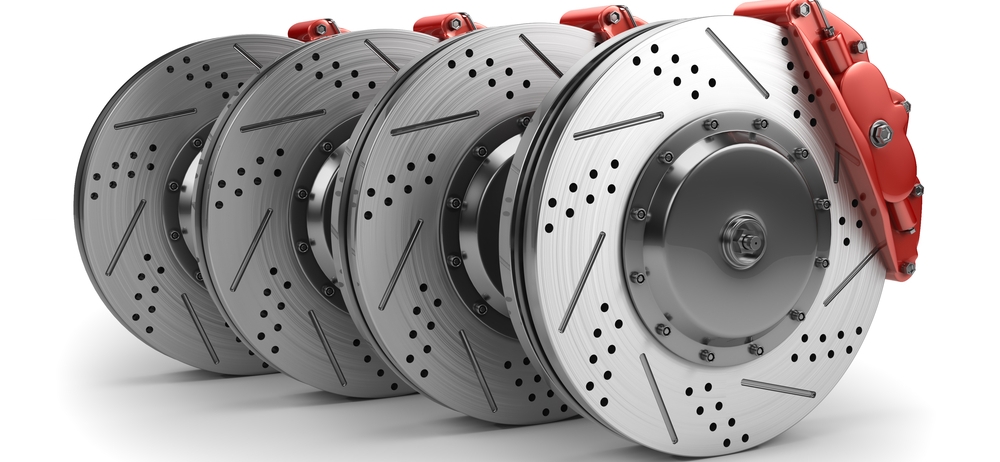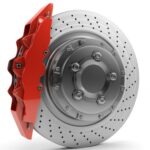- April 30, 2022
- Posted by: Wentworth
- Category: Brakes

 Now it’s time to examine the specifics of Disc Brakes in Part 3 of our Automotive Brakes Blog Series. We will review how disc brakes operate and which vehicles come equipped with disc brakes. We’ll look at the components found in the disc braking system, including the rotors, calipers, master cylinder, and brake pads. If you have problems with your disc brakes, continue reading to find out how to diagnose common disc brake issues. And finally, we will discuss routine disc brake maintenance, repairs, and brake fluid intervals.
Now it’s time to examine the specifics of Disc Brakes in Part 3 of our Automotive Brakes Blog Series. We will review how disc brakes operate and which vehicles come equipped with disc brakes. We’ll look at the components found in the disc braking system, including the rotors, calipers, master cylinder, and brake pads. If you have problems with your disc brakes, continue reading to find out how to diagnose common disc brake issues. And finally, we will discuss routine disc brake maintenance, repairs, and brake fluid intervals.
What are Disc Brakes?
Disc brakes produce increased stopping ability and overheat less quickly than drum brakes. Most modern vehicles come equipped with four-wheel disc brakes, including sedans, trucks, SUVs, and high-performance cars.
How Do Disc Brakes Work?
Disc brakes use force applied on flat discs attached to the wheels. When you engage the brake pedal, the master cylinder pressurizes the brake fluid, then moves the pistons and pushes the brake pads against the rotors. This force effectively slows and stops your vehicle. When the disc brakes are applied, the brake pads move only a few millimeters and should retract back into the calipers as soon as the brake pedal is released.
Disc Braking System Components
The components found in the disc braking system consist of the following:
- Brake Pads: Brake pads are composed of a metal shoe and an attached lining made from either organic, semi-metallic, or ceramic materials. The lining comes into direct contact with the rotor, creating friction. The brake pads eventually wear down with use. Different lining materials wear at different rates. They also can affect the brake-life length, the amount of noise generated when applying the brakes, and how quickly the brakes slow and stop your vehicle.
- Calipers: Calipers hold the brake pads, pistons, and lines for brake fluid. There are two styles of brake calipers: Floating and Fixed.
-
-
- Floating calipers have pistons on one side, so they press the brake pads into the rotor on only one side, which causes them to slide back and forth over the rotor. Most vehicles come equipped with floating calipers.
- Fixed calipers are fastened in place and have pistons on both sides of the rotor. Fixed calipers apply brake pressure more evenly and firmly on the rotor.
-
- Master Cylinder: The master cylinder works like a hydraulic pump with a brake fluid reservoir. When the driver applies the brakes, fluid flows through the brake lines to the braking system, converting the pressure from the brake pedal to stopping power. Modern master cylinders have two chambers, each operating one pair of wheels. This design prevents total brake loss since the failure of both cylinders simultaneously is improbable.
- Piston: The piston moves the brake pads against the rotor with hydraulics when the driver engages the brake pedal. A vehicle’s braking system can employ one to eight pistons to push the brake pads from each side of the rotor.
- Rotors: A rotor is a round disc attached to the wheel hub that rotates with the wheel. Most rotors are made from cast iron or steel. High-end luxury automobiles use rotors made from carbon-ceramic materials. Rotors are flat but can have slots or holes to dissipate heat more effectively.
- Sensors: Certain vehicles come equipped with sensors inside the brake pads that signal when to replace the pads.
Diagnose Disc Brakes Issues
Brakes are among the most crucial safety systems in your vehicle. Auto manufacturers designed disc brakes to provide reliable and consistent braking. Be aware of any changes to your vehicle’s braking behavior that indicate that your disk brakes need service, repair, or replacements.
- Shaking Brake Pedal: If the brake pedal shakes or vibrates when you use it, the chances are good that there is warping in your rotors. Brake rotors must be perfectly flat to operate correctly. Warping to the rotors can occur through overuse or overheating. Fortunately, your service technician can inspect and either resurface or replace the rotors to restore safe braking.
- Squealing or Screeching Noise: When the brake pad material wears down, a metal wear-indicator inside the pad will connect with the rotor, creating a squealing or screeching sound. Therefore, make sure your service technician inspects and replaces the brake pads when necessary.
- Spongy or Sinking Brake Pedal: The brake pedal should feel firm and require the same amount of pressure each time you use it. Suppose the pedal feels spongy or sinks lower than usual. There may be a faulty master cylinder, contaminated brake fluid, or a leak in the system. If this occurs, have your service technician inspect and repair the issue.
Routine Disc Brake Maintenance & Repair
All vehicles require routine maintenance to their disc brake systems. Maintenance includes regular inspections, periodic brake pad replacement, and occasional repair. You should consult your owner’s manual for the manufacturer’s suggested interval for your vehicle.
However, expect to replace your brake pads every 25,000 to 70,000-miles. Brake rotors may last 50,000 to 70,000-miles, depending on road conditions, terrain, and driving style. Brake fluid should be inspected every 24,000 to 36,000-miles, and schedule a brake service if you suspect a brake fluid leak.
Schedule Disc Brake Maintenance & Repair
Correctly maintaining and repairing your disc brakes is our top priority at Wentworth Automotive. All our technicians are ASE Certified & Master Mechanics. We use nothing but high-quality auto parts in all our brake repairs and replacements. Your safety depends on the mechanical condition of your vehicle. We work hard to provide quality brake service at an affordable price, backed by our automotive warranty.
For disk brake maintenance & repair, trust Wentworth Automotive with your car, truck, or van. To learn more about our brake repair services, don’t hesitate to contact us by phone at (858) 541-1044 or visit our website to make a reservation today.
Next Blog – Automotive Brakes Part 4 | Regenerative Brakes and Repair
Previous Blog – Automotive Brakes Part 2 | Drum Brakes & Repair

